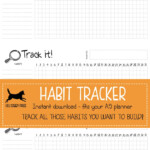Habit Tracker Template Atomic Habits – Ever wondered why some individuals have the ability to meet their goals effortlessly but others have difficulty? The secret to success may be in a straightforward yet powerful tool called Habit Tracker Printable. But what is it, and how does it change your daily routine? Learn more.
Understanding the Importance of Habit Tracking
Habit tracking is more than simply ticking checkboxes off on an item of paper. It’s a deliberate, mindful way to build healthy habits.
The role of habit tracker printables
Printable habit tracker worksheets are an effective visual reminder they can also act as a partner in accountability. They give you the ability to keep track of your progress while encouraging you to stick to your goals.
Use of a Habit Tracker Printable
An easy-to-use habit tracker can be easily used however it is a commitment to honesty.
Choosing Habits to Keep
In the beginning, you must make choices that align with your objectives. It could range from reading for a minimum of 20 minutes each day, to practicing yoga, or even drinking eight glasses of water a day.
Logging Your Progress
Keep track of your progress each day in the habit tracker. This process takes only few minutes, but will provide valuable insight into your habit-building journey.
Analyzing Performance
In time, your capacity to spot patterns and obstacles will improve.
The Advantages of Habit Tracker Printables
Downloadable habit tracker printables offer many additional benefits besides helping you develop new behaviors.
Enhance Self-Awareness
By keeping track of your daily habits, you increase your self-awareness and gain insight into what works for you, and what doesn’t.
Productivity Enhancing
If you have a clear picture of your routines every day and habits, you can cut out ineffective habits and concentrate on the ones that will contribute to your personal and professional improvement.
Encourage Consistency
Habit tracker printables encourage the habit of being consistent, which is crucial to turning sporadic activities into ingrained behaviors.
Tips for Creating a Habit Tracing
Utilize these guidelines to make the most of your printable habit tracker.
Start Small
Choose one or two habits at a time. This will allow you to not feel overwhelmed and more likely to stick to the new routines.
Be Consistent
Consistency is the key factor in the process of habit formation. You must keep trackers of your habits on paper each day.
Celebrate the Successes
Recognize your wins however small. This is the best way to boost your positivity and keep you focused.
For a final note, printable habit trackers are an effective tool to help you to develop and maintain healthy behaviors. Visual reminders can be an effective tool for personal growth. Always start small, keep going, and don’t forget to recognize your accomplishments.
Frequently Asked Questions
- Where can I get templates for habit trackers?
- Online, you’ll discover printable forms for keeping track of your habits on numerous websites. Some websites offer them free of charge and some may charge a fee for specialized versions.
- Do I have to utilize an electronic tracker for my habits rather than a paper one?
- Absolutely! Numerous digital habit tracker applications are readily available. Some people prefer the physical act of noting off a habit that has been completed to be more satisfying and tangible.
- What number of behaviors should I track at once?
- Begin with a small amount. It’s recommended to focus on one or two habits at first. Once you’ve successfully incorporated these habits into your daily routine, you can begin adding more.
- About how long does it usually take for a new habit to be established?
- According to studies, it could take between 21-66 days for an habit to be formed. The time needed to develop a habit could depend on a person’s level of complexity and personality.
- Do you know what I should do if my habit tracker isn’t complete?
- It’s perfectly normal to miss the odd or two days. It’s important to not let this deter you. Instead, use it as an opportunity to learn what you did not learn and what you can do to avoid this from happening again.


